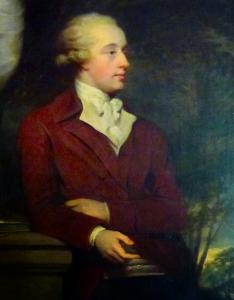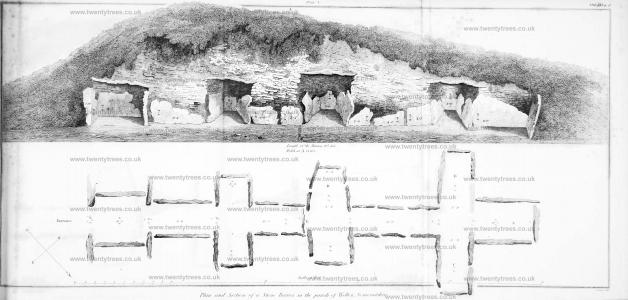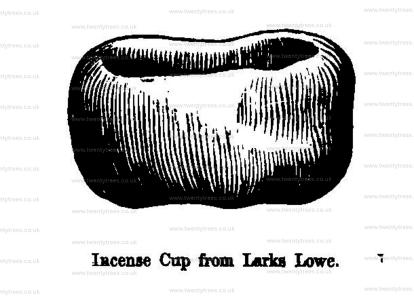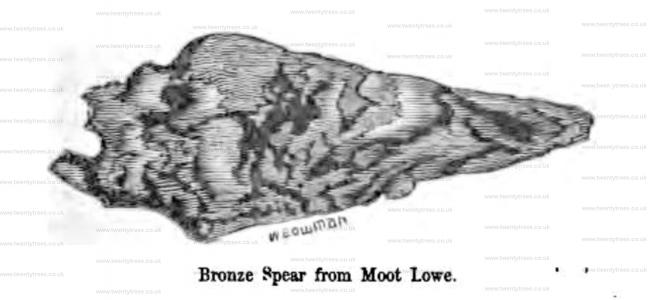Biography of Richard Colt Hoare 2nd Baronet 1758-1838
Paternal Family Tree: Hoare
Richard Colt Hoare 2nd Baronet 1758-1838 is in Antiquaries.
3500BC. Stoney Littleton Long Barrow [Map] is a Long Barrow constructed around 3500BC ±500 years around 7.5km south of Bath on high unlevel ground above a bend in the River Wellow. It is a Severn Cotswolds type tomb. The stone structure is about 30 metres in length, 3m high, and contains a 12.8 metres long gallery with a roof of overlapping stones with three pairs of side chambers and an end chamber. The tomb was excavated by Richard Colt Hoare 2nd Baronet in 1816-1817.
Between 2000BC and 800BC. Oakley Down Barrow Cemetery, Dorset [Map] is a group of around thirty Bronze Age Round Barrows. Many of the barrows were excavated in the early 19th century by Richard Colt Hoare 2nd Baronet and William Cunnington.
Amesbury 42 Long Barrow [Map] is a Long Barrow at the end of the Stonehenge Greater Cursus. It was noted by William Stukeley (age 35) in 1723 and Richard Colt Hoare 2nd Baronet (age 51) in 1810. It was excavated by John Thurnam in 1810 who recovered an Ox Skull and discovered secondary inhumations. The barrow is now levelled.
Before 1758 [his father] Richard Hoare 1st Baronet (age 22) and [his mother] Anne Hoare (age 20) were married. They were first cousins.
On 09 Dec 1758 Richard Colt Hoare 2nd Baronet was born to Richard Hoare 1st Baronet (age 23) and Anne Hoare (age 21). Coefficient of inbreeding 3.12%. 
After 1759 [his father] Richard Hoare 1st Baronet (age 23) and [his step-mother] Frances Anne Acland (age 24) were married.
On 05 May 1759 [his mother] Anne Hoare (age 21) died.
 Around 1783. Prince Hoare (age 28). Portrait of Richard Colt Hoare 2nd Baronet (age 24).
Around 1783. Prince Hoare (age 28). Portrait of Richard Colt Hoare 2nd Baronet (age 24).
On 18 Aug 1783 Richard Colt Hoare 2nd Baronet (age 24) and Hester Lyttelton were married.
In 1784 [his son] Henry Hoare was born to Richard Colt Hoare 2nd Baronet (age 25) and [his wife] Hester Lyttelton.
On 22 Aug 1785 [his wife] Hester Lyttelton died from childbirth giving birth to her second child who also died.
On 08 Sep 1785 [his grandfather] Henry Hoare "The Magnificient" (age 80) died. He was buried at St Peter's Church, Stourton. His great-nephew Richard Colt Hoare 2nd Baronet (age 26) inherited his Stourhead, Wiltshire [Map] estates.
In 1786 [his father] Richard Hoare 1st Baronet (age 50) was created 1st Baronet Hoare of Barn Elms in Surrey.
In 1786 Richard Colt Hoare 2nd Baronet (age 27) purchased Glastonbury Tor and restored the church tower on its summit.
On 11 Oct 1787 [his father] Richard Hoare 1st Baronet (age 52) died. His son Richard Colt Hoare 2nd Baronet (age 28) succeeded 2nd Baronet Hoare of Barn Elms in Surrey.
In 1792 Richard Colt Hoare 2nd Baronet (age 33) was elected Fellow of the Royal Society and Fellow of the Society of Antiquaries of London.
In 1805 Richard Colt Hoare 2nd Baronet (age 46) was appointed High Sheriff of Wiltshire.
On 04 May 1808 Reginald Pole aka Pole-Carew (age 54) and [his former sister-in-law] Caroline Anne Lyttelton (age 33) were married. The difference in their ages was 21 years.
On 14 Sep 1808 [his former father-in-law] William Henry Lyttelton 1st Baron Lyttelton (age 83) died. His son [his former brother-in-law] George Fulke 2nd Baron Lyttelton (age 44) succeeded 2nd Baron Lyttelton of Frankley in Worcestershire, 2nd Baron Westcote, 8th Baronet Lyttelton of Frankley.
Colt Hoare 1812. The Ancient History of Wiltshire Volume I by Richard Colt Hoare 2nd Baronet (age 53). Introduction by Jack Simmons and D. A. Simpson. This edition originally published by William Miller, London 1812 and Lackington, Hughes, Harding, Maver and Lepard, 1821.
Colt Hoare 1812. The Ancient History of Wiltshire by Richard Colt Hoare 2nd Baronet (age 53).
In Mar 1813 [his former brother-in-law] William Henry Lyttelton 3rd Baron Lyttelton (age 30) and Sarah Spencer (age 25) were married. She the daughter of George John Spencer 2nd Earl Spencer (age 54) and Lavinia Bingham Countess Spencer (age 51).

Archaeologia Volume 19 Section IV. 1816. An Account of a Stone Barrow [Map], in the Parish of Wellow, at Stoney Littleton [Map] in the County of Somerset, which was opened and investigated in the Month of May 1816. Communicated by Sir Richard Colt Hoare (age 57), Bart. F.S.A. Read 22d May, 1817.

Section I Tumuli 1825. The only barrow yet discovered in a low situation in the neighbourhood of Middleton is placed in a meadow called Larks Lowe [Map], and near the rivulet called the Bradford; this tumulus was opened on the 20th of May 1825 when the cist was found to be constructed of large flat stones placed edge-ways with similar ones serving for the cover; it contained the decayed fragments of a human skeleton. On the eastern side of the barrow was found an urn of coarse earthy full of calcined bones and dry mould, the top protected by a flat piece of lime-stone, upon which was placed a small, shallow, earthen vessel very firmly baked, (of the kind denominated by Sir Richard Hoare (age 66) "incense cups"), a pin of bronze, two and a quarter inches long; several animal teeth and bones, amongst them a horse's tooth, a circular pebble, and a stone of peculiar shape; the large urn was of so friable a nature, that it probably had no other baking than what it received in the funeral fire, from this cause it was found impracticable to preserve it entire. June 19, 1826, it was thought advisable to reopen the very interesting barrow [Map] on Garratt Piece, Middleton, which was opened by Dr. Pegge in 1788, and described in the Archæologia, vol. ix, page 189; in it were found animal bones, one of which was calcined; a portion of the lower branch of an antler of the red deer, six inches in length, which had been tooled at the root by a sharp instrument; also some rats' bones. (See a subsequent examination of this barrow.)

On 12 Nov 1828 [his former brother-in-law] George Fulke 2nd Baron Lyttelton (age 65) died unmarried. His brother [his former brother-in-law] William Henry Lyttelton 3rd Baron Lyttelton (age 46) succeeded 3rd Baron Lyttelton of Frankley in Worcestershire, 3rd Baron Westcote, 9th Baronet Lyttelton of Frankley.
On 10 Apr 1833 [his former sister-in-law] Caroline Anne Lyttelton (age 58) died.
In 1836 [his son] Henry Hoare (age 52) died.
On 30 Apr 1837 [his former brother-in-law] William Henry Lyttelton 3rd Baron Lyttelton (age 55) died at Spencer House. His son George William Lyttelton 4th Baron Lyttelton (age 20) succeeded 4th Baron Lyttelton of Frankley in Worcestershire, 4th Baron Westcote, 10th Baronet Lyttelton of Frankley.
On 19 May 1838 Richard Colt Hoare 2nd Baronet (age 79) died. He was buried at St Peter's Church, Stourton. His half brother [his half-brother] Henry Hoare 3rd Baronet (age 76) succeeded 3rd Baronet Hoare of Barn Elms in Surrey.
Section I Tumuli 1843. The first tumulus opened this season was situate upon the Meadow-place Farm, near Yolgrave, and is generally known as Bee Lowe [Map]; it was decided upon to open it on the 16th of June, when it was found to be impossible to excavate it in a proper manner, owing to the trees growing upon the sides; therefore the only method of examining it was by sinking a hole down the centre of the mound, which consisted of loose earth and stones, amongst which a profusion of rats' bones was met with. In the course of this excavation the broken fragments of a human skeleton were turned up, which made it evident that one interment at least had been disturbed at some former period. Amongst these bones were found a small arrow-head of flint, elegantly formed, two rude instruments of the same material, and about half a dozen horse's teeth. On reaching the native soil, which was about four feet from the top of the barrow, the primary deposit was found, consisting of burnt bones, amongst which was part of a bone pin, also calcined; and near to the same place lay some fragments of a well-baked clay urn, very tastefully ornamented with a chevron pattern, and which had been of the form of vessel designated "drinking cups" by Sir Richard Hoare, by which name they will be distinguished in the subsequent parts of this work, as a simple way of expressing their difference from the sepulchral urns and incense cups, although it is by no means certain that they were made use of for the purpose implied by the words "drinking cup."
Section I Tumuli 1844. On the 6th of May, 1844, was opened a large flat barrow called Moot Lowe [Map], situated about one mile south-west from Grange Mill, in a field of considerable elevation and rocky surface. The tumulus is about fifteen yards in diameter, and about four feet high, with a level summit. The section was made by cutting through the centre of the barrow from east to west; when within about four yards from the middle, a secondary interment was discovered very near the surface, which consisted of a deposit of burnt bones placed in a large urn, measuring about sixteen inches in height, and thirteen in diameter at the mouth, which was broken, owing to its being so superficially covered; since being restored, it exhibits a very curious appearance, being ornamented in a different manner to any yet discovered in Derbyshire; when found, it lay on its side, and on carefully collecting the pieces, and the bones it contained, a small brass spear-head, or dagger, was found amongst the latter; it is three inches and a quarter in length, and has a hole through which it has been riveted to the handle or shaft; two very similar in size and form are engraved in Sir Richard Hoare's 'Ancient Wiltshire,' vol. i, plates 11, 28. This is the first recorded discovery of a weapon of this description in this county, though subsequent researches have proved them to be by no means rare.
Nearer the centre a much earlier interment was found, namely, a human skeleton with the knees drawn up, lying on some large limestones, and not accompanied by any utensils. The ground in the centre of the barrow was found to be four feet lower than the level of the native surface in other places, probably owing to the rocky and unequal surface of the field before mentioned; it was fiUed up with stones free from soil, to the level of the other ground, beneath which nothing was found, although such was expected to be the case. Dispersed through the mound the following articles were observed: teeth of swine and other animals, a small piece of another urn, chippings of flint, and a few rats' bones. About four hundred yards from the preceding there is a small portion of another barrow, also named Moot Lowe [Note. Presumed to be Moot Low 2 Barrow [Map]], which was long since almost razed to the ground; on the afternoon of the 6th of May the site was dug over, and a few human and animal bones brought to light; the former indicated the interment of two individuals, and the latter included the well-known rats' bones.

Diary of a Dean by Merewether. The apex of Windmill Hill is surrounded by a slight and single foss, in diameter — for it is almost an exact circle about 150 yards. Within this, at the south-east, are two large harrows; one has evidently been reduced for agricultural purposes; and I have since learned that in it were found seven skeletons, and a very beautiful little grape urn, according to Sir Richard Colt Hoare's nomenclature, which I have seen, and of which I hope to supply a sketch. The skeletons were deposited in the side of another barrow, but which I could not learn. Now it is on record, that both Dr. Stukeley and Sir Richard opened barrows on this hill; one or two confess to this; but there are several toward Avebury, on the slope of the hill, which the plough has worn down, and of these it is of course impossible to judge with any certainty; but several such there are, which look very inviting. We were singularly favoured. Three on the east side of the hill were each productive of very interesting remains, one in particular. Commencing with the lowest on the hill's side, we will declare the result.
Diary of a Dean by Merewether. 10 Aug 1849 and 11 Aug 1849. No. 2, the first of a range of five large barrows in the rising ground to the north of the last, nearly in a line, a mile and a half north-east of Avebury. These differ in form, 2 and 3 being of the bowl-shape, the others of the more elegant bell-shape, as described by Sir R. C. Hoare in his Ancient Wilts. Although the second and third of this range were not opened until the 10th and 11th of August, I shall describe their produce with the others as belonging to a separate class. After a laborious excavation of the first (No. 2), from the apex to a depth of 10 feet, until we came to the natural chalk through a thin layer, at about 9 feet ,—i e. about the level of the surrounding ground,—of black mould composed of burnt wood, we were obliged to give up the hope of any marked discoveries here. The earth throughout was peculiarly moist, and probably indicated that this barrow had been examined before; there were, however, many fragments of the usual sort of bones and teeth and charred wood.
Wiltshire Archaeological Magazine 1885 V22 Pages 234-238. Extracts from a Note Book by Sir R C Hoare.
Nænia Cornubiæ by William Borlase Lanyon Cromlech. Coming further South the combined researches of Sir R. C. Hoare and Thomas Bateman, Esq., tabulated by Sir John Lubbock, show that out of some 500 interments explored with care, only thirty-seven were extended, while 112 were contracted, the rest being burnt.
Cursus Barrows. A Neolithic and Bronze Age round barrow cemetery located mostly south of the western end of the Cursus (Monument Number 219546). The cemetery extends 1200m east / west along a ridge and measures 250m wide. It comprises the round barrows recorded as Winterbourne Stoke 28 to 30 and Amesbury 43 to 56, plus the Fargo hengiform. All of the barrows were examined by Colt Hoare in the early 19th century. The round barrows were surveyed by English Heritage in 2009 and 2010 as part of the Stonehenge WHS Landscape Project.
Lugbury aka Littleton Drew Long Barrow [Map]. Historic England 1010397
The monument includes a long barrow set on level ground above the valley of By Brook, a tributary of the River Avon. It is orientated east-west and appears rectangular in shape. The monument measures 56m long, 38m wide and 1.5m high. Towards the eastern end of the mound are the remains of a limestone chamber comprising a capstone, 3m by 2m in size, leaning against the western side of two large uprights which measure 2m by 1m. Flanking ditches, from which material was quarried during the construction of the monument, run parallel to the north and south sides of the mound. These have been infilled over the years but survive as buried features c.3m wide. The monument was partially excavated by Colt-Hoare in 1821 and again by Scrope in 1854/5. Finds included twenty-six skeletons in four limestone chambers.
Great x 2 Grandfather: Richard Hoare
Great x 1 Grandfather: Henry Hoare 
GrandFather: Richard Hoare 
Father: Richard Hoare 1st Baronet 
Richard Colt Hoare 2nd Baronet 
Great x 2 Grandfather: Richard Hoare
Great x 1 Grandfather: Henry Hoare 
GrandFather: Henry Hoare "The Magnificient" 
Mother: Anne Hoare 
Great x 1 Grandfather: Stephen Colt
GrandMother: Susan Colt